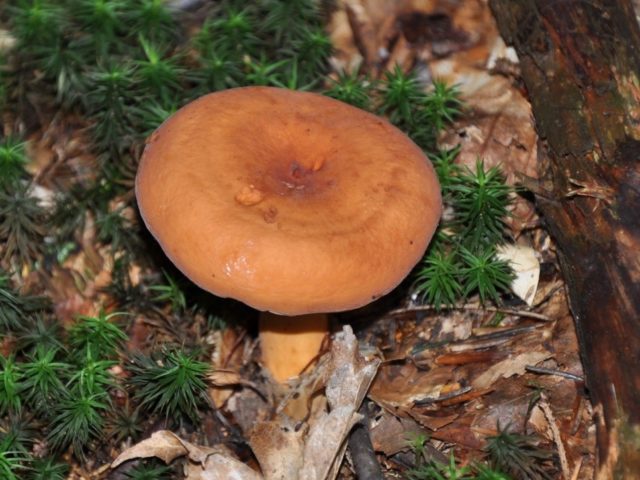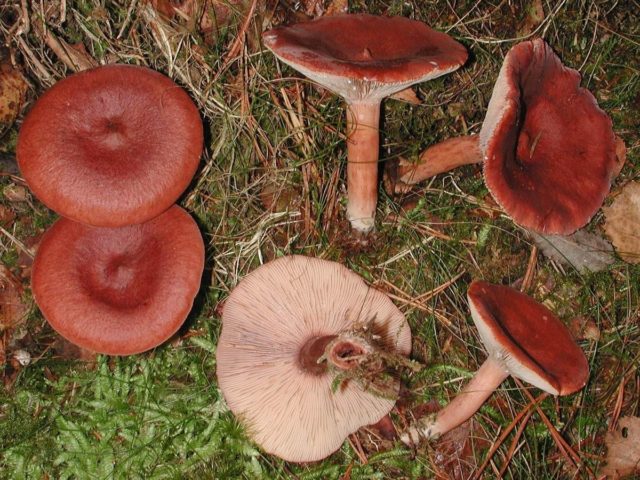Content
In forests of various types, the rubella mushroom, belonging to the Syroezhkovy family, is quite common. The Latin name is lactarius subdulcis. It is also known as a hitchhiker, sweet milk mushroom, sweetish milkman. Despite its prevalence, this species is not held in high esteem by most people due to its narrow use in cooking and the assigned category of conditionally edible mushrooms. However, this gift of the forest is quite nutritious, and with proper pre-processing, you can get a delicious snack from it.
Where does rubella grow
The rubella mushroom, photo and description of which is presented below, grows almost everywhere. It can be found in various types of forests on moss deposits. In the deciduous forest belt, this species prefers to form mycorrhiza with birch, oak or beech. Fruiting from mid-summer to late autumn, actively begins to grow after prolonged rains. Rubella (lactarius subdulcis) is one of the few fungi that tolerate short-term frosts and are found right up to the first snow. This species is quite often found in large groups throughout almost all of Europe.
What mushrooms look like

The pulp of this species gives off an abundant milky juice of a whitish color.
In this photo, you can see that the fruiting body of the hitchhiking mushroom consists of a lamellar cap and a thin leg. The cap is convex or depressed with a small central tubercle and tucked edges inward. It reaches up to 8 cm in diameter and is colored reddish-red. The surface is smooth or slightly wrinkled to the touch. On the inner side of the cap there are narrow, descending and frequent plates. Their color varies from whitish to light brown or pinkish. The spores are medium in size, spherical in shape with a mesh surface. Spore powder of creamy pinkish hue.
The leg is cylindrical, narrowed downwards, the thickness is 1.5 cm, and the length is 4-6 cm. It is characterized as straight, but in some specimens it may be slightly curved. Colored in lighter shades than the hat.
The flesh is firm and rather fragile, the color varies from white to nutty. When damaged, it secretes abundant milky juice, which remains unchanged in air. It is bitter in taste, exudes an unpleasant aroma, similar to the smell of rubber or bedbugs.
Is it possible to eat rubella mushroom
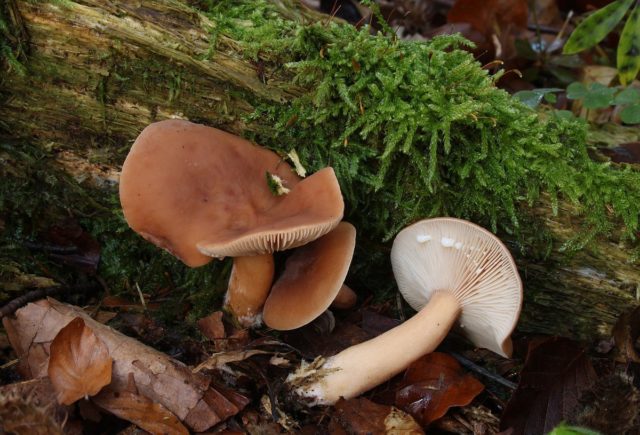
Most often, this species is located in large groups.
Rubella is assigned the 4th category of nutritional value, and therefore it is considered a conditionally edible mushroom. This specimen should not be eaten raw due to its inherent bitter taste. However, pretreatment can eliminate unpleasant bitterness. Due to their special fiber, the legs are not used for food, but the caps are suitable for pickling or salting.
False doppelgangers of rubella
In appearance, rubella are similar to other gifts of the forest:
- Milk lover - an edible mushroom that can be eaten even raw. It differs from the specimen under consideration in the large size of the fruit bodies, since the double's cap in diameter is from 5 to 16 cm, and the leg length can reach up to 10 cm.In addition, a plentiful milky white juice is released from the inside of the cap, which after a while is exposed to air turns brown.
- Bitter - is considered a conditionally edible mushroom, most often it is used for food in pickled or salted form after special preliminary processing. You can distinguish from rubella by the dark red or burgundy color of the cap and the more caustic bitter milky juice.
How to cook rubella mushrooms
This type can be used for food, but only after preliminary processing. This requires:
- To clear the mushrooms from forest debris.
- Cut off the legs.
- Transfer the hats to a deep container, fill with water, and put a heavy load on top. Soak for 24 hours. In this case, the water must be changed about 2 times a day.
- Rinse, boil in salted water for about 10 minutes, after which you can start preparing a dish from rubella mushrooms.
There is another processing option, where digestion is required instead of prolonged soaking. When deciding how much to cook rubella in this case, you need to take at least two hours for this process. Then the mushrooms are also washed under running water, after which they can be used in further cooking.
Rubella recipes
This specimen has found rather limited use in cooking. Rubella is not suitable for making soups and fried dishes, but in pickled or salted form it will become incredibly tasty and crispy.
How to cook rubella with potatoes
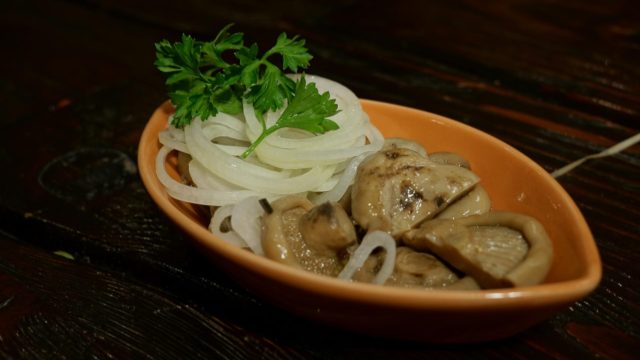
Sweet milk is a conditionally edible species.
Suitable exclusively for pickling and salting. However, in this form, rubella goes well with fried or boiled potatoes. Below are the recipes for making pickled and salted mushrooms.
How to salt rubella mushrooms

Millechnik sweetish has a very fragile pulp
The process of preparing salted gifts of the forest is as follows:
- Clean the rubella from dirt, remove the legs.
- Soak for a day.
- After this time, rinse.
- Divide into containers, caps down.
- Sprinkle with salt.
- Put the next layer of garlic, cut into slices, then - dill umbrellas and currant leaves.
- Cover the workpiece with a wide sheet of horseradish and press down on top with oppression.
- Send to refrigerator for 3 days.
- Transfer the mushrooms to pre-sterilized jars and roll up the lids.
- Let this dish brew for 40 days, after which it is ready to eat.
How to pickle rubella
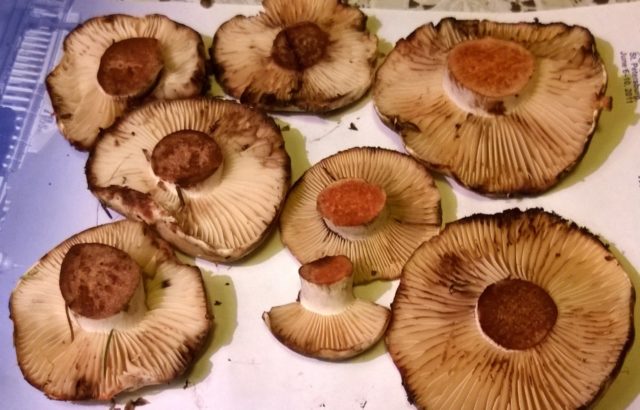
Sweet milk has a fibrous and bitter leg, for these reasons it is not eaten
The process of pickling rubella is not much different from pickling. However, in this case, instead of soaking, heat treatment of forest gifts is provided. So, to cook pickled mushrooms in a hot way, you will need the following products:
- rubella - 500 g;
- bay leaf - 1 pc .;
- garlic - 2 cloves;
- salt to taste;
- 9% vinegar - 2 tbsp. l.
Cooking method:
- Rinse the rubella, cut off the legs and put in a saucepan.
- Simmer in salted water for about 2-3 hours.
- Transfer the still warm gifts of the forest to prepared banks.
- Add spices, vinegar.
- Roll up sterilized lids.
- Wrap up and send to a dark place.
Conclusion
Rubella mushrooms are striking representatives of the forest, growing in various regions with a temperate climate. They are distinguished by their unpretentiousness and can grow up to the first snow cover. But despite the many advantages, they also have several disadvantages, one of which is the bitter taste of the pulp. It is for this reason that many mushroom pickers pass by these specimens. However, there are also those people who have appreciated the taste of pickled and salted rubella. When cooked properly, they stop bitter, become crispy and can even compete with other edible mushrooms.
